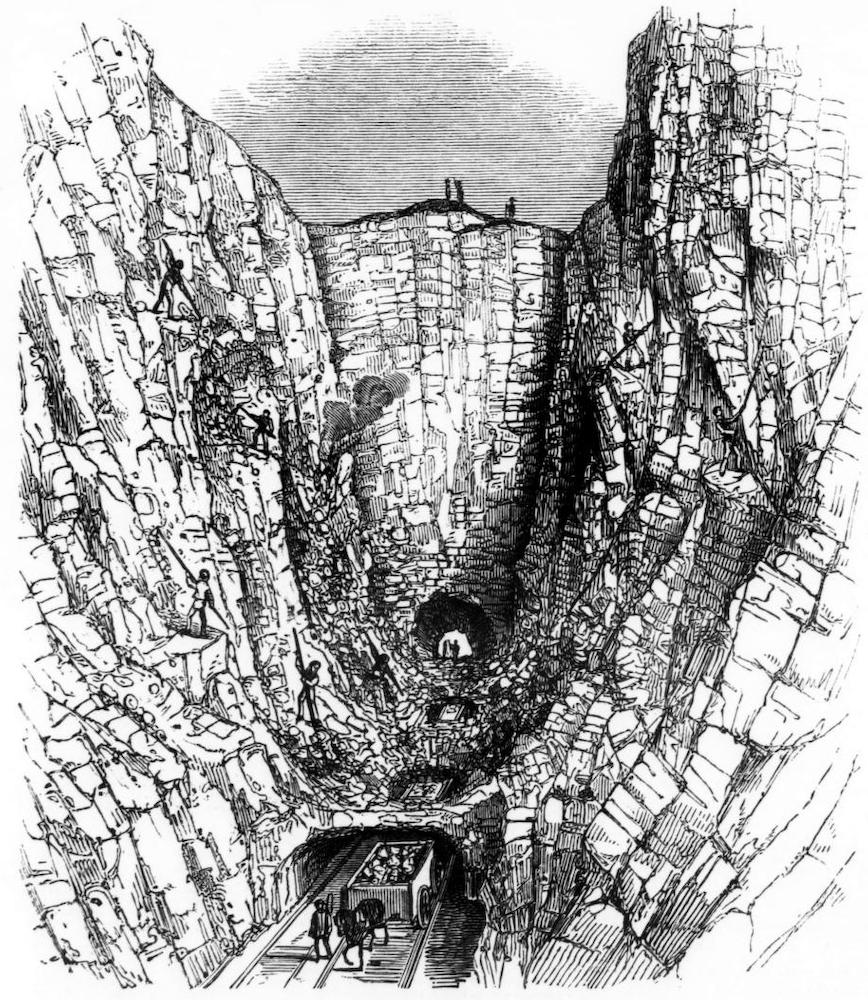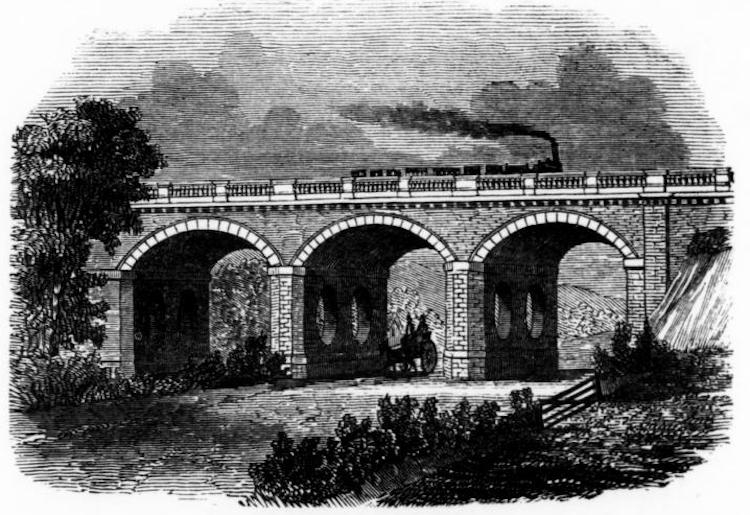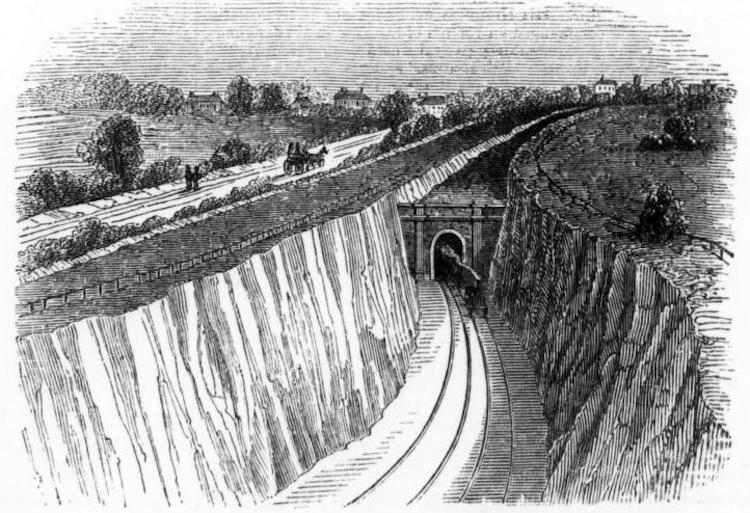This article from the Illustrated London News of 13 June 1846 had been scanned/copy-typed, arranged and formatted for the Victorian Web by Jacqueline Banerjee. See Related Material for some modern photographs, and the Bibliography for details of the source. You may use the images without prior permission for any scholarly or educational purpose as long as you (1) credit the person who scanned them and (2) link your document to this URL in a web document or to the Victorian Web in a print document. [Click on the images to enlarge them.]

The Brighton Viaduct across the Preston Road [or, The London Road Viaduct]: The whole length of the viaduct.
The Railway, as many of our readers are, doubtless, aware, forms a portion of the main trunk Southern Coast Line, between Portsmouth and Dover, and is the property of the London and Brighton Railway Company. That portion of it which extends from Brighton to Lewes, was inspected by General Pasley on the 3rd instant, and was opened for general traffic on Monday last.
The line has several works of considerable magnitude and interest; a few of which we have selected for illustration. It branches from the London and Brighton line immediately after passing the New England Viaduct, and then crosses the Preston Road by the Brighton Viaduct, a magnificent structure, consisting of an elliptic arch, 50 feet span, and 73 feet high; flanked, on one side, by 18, and the other by 9, semicircular arches, 30 feet span: the former are built on a curve of 3/4 mile radius, and the latter on a 10 chain radius: they are of the same height throughout, and to be finished by a bold cornice, and handsome balustrades. The length of the viaduct is 400 yards, and ten millions of bricks were used in its construction. In consequence of its being on the curve, one side is above 40 feet longer than the other; all the arches radiate towards the centre of the curve; and the piers are 1 foot 8 inches thicker at one end than the other, in order to have the openings parallel. General Pasley, at the inspection, expressed himself much delighted with this noble work.
The first stone was laid by W. Nash, Esq., Chairman of the Company, on May 28, 1845; and on the 28th of March following, the last arch was keyed in. Perhaps no similar construction has, either for its extent or its beautiful proportions, has ever been completed in a shorter space of time. When viewed from the point selected by our Artist, this elegant specimen of railway engineering is seen to most advantage: on the elevated ground to the right is the extensive Terminus of the London and Brighton Railway; and in front lies the town of Brighton, with its fine expanse of sea; a picture of no ordinary interest, and sufficient of itself to repay the investment of an excursion-ticket and a day’s holiday, independent of the many other attractions of this favoured locality.
One or these inducements is the interesting old town of Lewes, its castle and seven churches, and a host of other antiquarian relics. Proceeding thither, after crossing the Brighton Viaduct, we then pass through a short tunnel (sixty yards) beneath the Ditchling Road, and the deep chalk cutting on either side: we have engraved the latter; and our Artist has shown the mode adopted by Mr. Wythes, the contractor for the works, for getting and filling his chalk cuttings: the first step was to bore a hole, or heading, at the intended level of the railway, through the cutting; then, four shafts were sunk into the heading from the top, at from 18 to 20 feet apart, down which the chalk rolled into waggous placed beneath, when it had once been loosened by the men with their picks. Just beyond the cutting, a bridge crosses the road, forming the northern boundary of the parish of Brighton. After passing through another cutting of considerable depth, the line extends along the side of the hill at the back of the Cavalry Barracks; and consists of embankment and cutting combined. Another cutting brings us to Moulscombe, a neat villa, the grounds of which are bisected by the railway, and again connected by a bridge.


Left: The Rose Hill Cutting. Right: The Hodshrove Skew-Bridge.
A deep cutting brings us to Hodshrove, where the Lewes turnpike-road is crossed by a skew-bridge of three arches, which we have engraved: the arches are of noble proportions and massive strength. From this point, the line, which had, hitherto, run on the western side of the Lewes road, lies entirely on the eastern side. A high embankment and a deep cutting follow; and we then pass a long embankment, skirting the front of the Earl of Chichester’s park, at Stanmer. This is the most beautiful domain on the line: the estate comprehends the whole parish and village of Stanmer, including the church; this park occupies a valley formed by one of those bold ranges of hills which adorn the coast of this county, and its undulatory surface, varied by thick masses of foliage, forms a rich contrast to the open downs by which it is environed.
Stanmer embankment brings us to the foot of Falmer Hill, where a cutting commences and is succeeded by a Tunnel, 500 yards in length, followed by a long and deep cutting; then a shorter one, and we obtain a sight of Lewes, St. Anne’s Church and the Castle being the most prominent objects. Nothing remarkable after this till we reach the foot of Water Shoot Hill, where the Railway crosses the Winterbourne; and, taking a curve to the right by a short tunnel, enters Southover, passing under the road, which leads from Lewes to Newhaven. It then crosses the Priory grounds (engraved in the number of our Journal detailing the recent antiquarian discoveries there), and thus arrives at the Lewes Station, which is in High-street, at the foot of School Hill.

The Falmer Tunnel.
The Engineer-in-Chief of the line is Mr. J. U. Rastrick; Mr. George Wythes being the contractor for the entire works, which have been executed under the direction of the Resident-Engineer, Mr. G. Meredith. We are indebted for some details to Mr. H. P. Birt, as well for the assistance afforded by him to our artist in sketching the annexed views. A portion of the descriptive details is extracted from the Brighton Gazette.
The line was opened to the public, as we have stated, on Monday last; and on the same day was opened the line to Chichester; thus extending the “iron way” east towards Dover, and westward towards Chichester, in part of the great trunk Southern Coast Line. At Lewes, the event was celebrated by a general holiday on Monday; and it is curious to reflect that the railway passes very nearly in the “route of Ravenna’s,” along which the Roman soldiers marched nearly 1800 years since,— “by Stanmer and Falmer,” to the station Mutuantonis, now Lewes. The railway extension in the opposite direction to Chichester, the site of the Roman Regnum, is of equal historical interest, — in associating the era of the colonizing of Britain with the noblest triumph of her civilisation — the Railway of our own Times. [388-89]
Links to Related Material
- Modern photographs of the viaduct crossing the Beaconsfield Road into Brighton
- Modern photograph of the Hodshrove Skew-Bridge across the Lewes Road
Bibliography
"The Brighton, Lewes, and Hastings Railway, Opened to Lewes." The Illustrated London News. 13 June 1846. Vol. 8: 388-89. Internet Archive. Web. 17 March 2024.
Created 17 March 2024